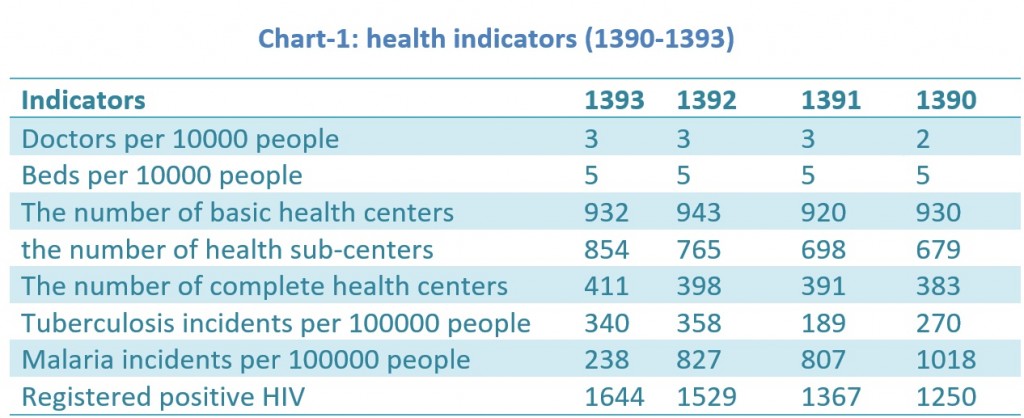Health sector: the background and current condition
Alike other sectors, health was also hit by civil war in Afghanistan; but after 2001, efforts has been made to improve this sector in the country; many governmental and private hospitals were built and measures were held to graduate cadres in this section. In this regard the International Community has also financially supported Afghanistan for instance financial aids of World Bank, United Nations, European Union and countries such as Turkey, Japan, and Italy.
Despite all these efforts, Afghanistan is still facing lots of problem in the health sector. Last week, UNAMA and UNICEF jointly released a report about children’s access to essential health and education services. According to the report, the health sector is in a very bad condition and health report covers worsened health situation and the problems that health personnel are faced with many problems.
The background of Health sector in Afghanistan
Before the Soviet invasion of Afghanistan the condition of the Afghan health sector was somehow good and was among the countries where measles was first eradicated. After the Sour coup d’état, the government was providing all services including health services and in 1357 there were 885 doctors and 997 nurses in the country, and there was one doctor for every 17000 people and one nurse for every 15000 people.
On the other hand, in Mujahedeen front health services were being provided through mobile service centers and for the afghan refugees in Pakistan, some regional and international organizations provided health services.
After the Civil War and in the Taliban regime, beside some governmental hospitals most of health services were being provided by NGOs. In 1369 there were 2504 doctors, 557 pharmacists, 4366 health personal, 143 basic health centers, 29 health sub-centers and 5667 beds throughout the country. After 2001, health condition in the country relatively improved. The former Afghan Health Minister Dr. Fatami said during an interview with BBC in 2006 that there was an overall 7100 doctors in the country which means that there was one doctor for every 3100 people.
The status of health sector 1390-1394
In 1390, there were two doctors for every 10000 in the country, and in 1391, 1392 and 1393 this number increased to three doctors for every 10000 people. In the meanwhile there were 5 hospital beds for every 10000 people. But the numbers of health sub-centers increased in these four years. (For further information see the chart below)
Compared to other countries, the health sector in Afghanistan is in a very bad condition. In Cuba, which has the best health services in the world, there are 672 physicians for every 100 thousand people. In Europe there are around 300 physicians for every 100 thousand people, while coming to Pakistan and India the number decreases to 83 and 70 physicians for every 100 thousand of population which does not indicates a better health condition but in Afghanistan we only have 30 physicians per 100 thousand people which is really not sufficient[1].
According to the joint report of UNAMA and UNICEF, they have documented 125 conflicts related incidents in the country which have reduced the availability of healthcare, while in 2013 and 2014 this number was 59 and 23[2].
According to the report, the two institutions have documented 15 incidents of threats and intimidations in 2013, 23 in 2014 and 64 in 2015 which have directly limited children’s access to health due to forced closures, looting of clinics, military use of clinics, intimidation of healthcare workers and the suspension of vaccination campaigns.
UNAMA and UNICEF have also documented killing 20 health workers and injuring 43 in 2015, 49 of which were killed or injured as a result of airstrike by United States forces on a MSF hospital in Kunduz.
In 2015, 66 incident of health workers abduction which shows an increase compared to 31 incidents in 2014 and 10 in 2013. In these three years 90000 children missed immunization due to the deteriorated security situation.
The Challenges Ahead
Substandard Medicines: despite improvements in the health sector in the past one and a half decade the substandard medicines are still being imported to the country.
Lack of qualified physicians: Afghanistan has a low level of education and medical education is no exception. Due to the substandard medicine and lack of qualified physicians in the country, Afghan patients go for treatment in Pakistan, India and some other countries.
Corruption: vast corruption in the country, on the one hand has resulted in importations of substandard medicines in the country and on the other hand it has led the medicines to be distributed by disqualified pharmacists who have fake documents. This option is very much in remote areas. The corruption has also influenced the standardization and oversight of pharmacies and private hospitals.
High death tolls from diseases: some diseases have high rates of death, but neither preventive measures nor medical treatments were considered to deal with them. For example, according to the World Health Organization (WHO), only tuberculosis kills 14000 Afghans every year[3] and also the rate of deaths by cancer reaches to 20000 Afghans every year[4], Afghanistan also has a high maternal mortality during childbirth.
[1] Central Intelligence Agency, Country Comparison to the World, See online: https://www.cia.gov/library/publications/the-world-factbook/fields/2226.html
[2] UNAMA and UNICEF, Children in Afghanistan struggle to access education and healthcare, see it online:
www.unicef.org/media/media_90885.html
[3] Azadi Radio (RFEL), Salana 14000 tan dar asar tuberclouse dar Afghanistan az bayn me rawand, see it online:http://da.azadiradio.com/a/27632961.html
[4] 1TVNews, Cancer kills 15000 to 20000 each year in Afghanistan, see it online: http://1tvnews.af/en/news/health/20710-cancer-kills-15000-to-20000-each-year-in-afghanistan


